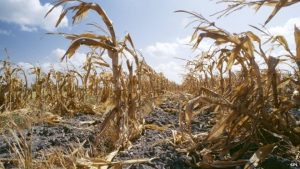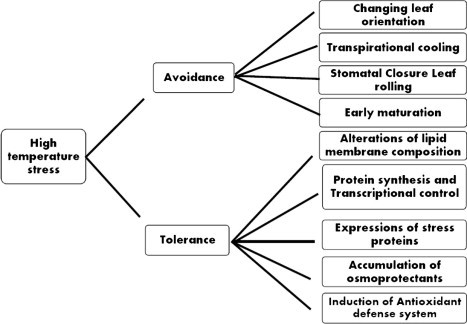
A dead crop that has experienced extreme drought Source: Inhabitat.com (2017).
Average global surface temperatures around the world are increasing (Carlowicz, 2010) as a result of increased carbon dioxide in the atmosphere.

Annual average global surface temperatures since the industrial revolution. Source: Climate.gov (2017)
All organisms have a narrow temperature range within which they function best and a broader range they can tolerate. Organisms that can easily move, for example animals, will move to stay within these limits. Plants however are unable to get up and move to maintain these limits in an individual’s life time, though with subsequent generations they can, through seed dispersal (Felde, Kapfer and Grytnes, 2012). But in order to do this they need to survive in the short term.
So the question is how do they do this?
Temperature is one of the most important factors that affects plant development. It controls the rate of most of the reactions occurring inside the plant and increases the storage of sugars inside the plant. As temperatures increase, the impact of the other growth limiting factors become more apparent, especially drought, as higher temperatures increases the rate of transpiration, the process that moves water through the plant.
In general:
Warmer temperatures = Faster Growth + more water consumption
As most gardeners know, extremes of temperature can be deadly. Low temperatures can cause freezing within the plant, which although rare, causes cell death. High temperatures cause not only loss of water and therefore wilting, but with long-term/extreme exposure causes a breakdown of the proteins insides the plant cells (Mathur, Agrawal and Jajoo, 2014), reducing their function, and ultimately causing death. Differences in morphology allow for plants to have varying tolerances to temperature extremes such as fleshy leaves, classic of succulents.

Healthy plant (left), Wilted plant (Right) Source: Chng, (2017)
Temperature also has a very pronounced effect on photosynthesis, the process by which plants produce food. The optimum temperature varies by species and will have adapted to work best in their given environment. The genetics of an organism may also determine the tolerance of temperature change; for example plants containing a specific gene for carbon fixation have a higher tolerance to warm temperatures compared to those who don’t have it. (Berry and Bjorkman, 1980).
Some species such as Eucalyptus pauciflora (Berry and Bjorkman, 1980), have a natural flexibility with optimal temperature for photosynthesis, which closely follows seasonal changes in air temperature. Plants with such natural flexibility will likely more readily adapt to the changing climate.
Pollination and seed development are one of the most temperature sensitive processes in the plant life cycle, but there are very few adaptations to combat this; in an experimental study (Hatfield and Prueger, 2015), the seed development in maize was reduced by 80-90% with increased temperatures. Without mechanisms in place to reduce this effect, it makes it more important for adaptations in other life cycle stages to reduce the impact of temperature variation.

A summary of the different techniques plants can use to reduce high temperature stress. Source: Mathur, Agrawal and Jajoo, (2014)
To survive short term plants may employ a variety of techniques shown in the image above. The long term adaptation of maximizing photosynthesis allows plants to make the most of the changing environment, and allows the plant to survive long enough to reproduce.
Word Count:499
References
Berry, J. and Bjorkman, O. (1980). Photosynthetic Response and Adaptation to Temperature in Higher Plants. Annual Review of Plant Physiology, 31(1), pp.491-543.
Carlowicz, M. (2010). World of Change: Global Temperatures : Feature Articles. [online] Earthobservatory.nasa.gov. Available at: https://earthobservatory.nasa.gov/Features/WorldOfChange/decadaltemp.php [Accessed 21 Mar. 2017].
Chng, J. (2017). Healthy Wholesome Food ~ Be a WISE Consumer to safeguard your HEALTH. [online] Healthywholesomefood.blogspot.co.uk. Available at: https://healthywholesomefood.blogspot.co.uk/search/label/e%20excel%20orchestra [Accessed 21 Mar. 2017].
Climate.gov. (2017). Why did Earth’s surface temperature stop rising in the past decade? | NOAA Climate.gov. [online] Available at: https://www.climate.gov/news-features/climate-qa/why-did-earth%E2%80%99s-surface-temperature-stop-rising-past-decade [Accessed 21 Mar. 2017].
Felde, V., Kapfer, J. and Grytnes, J. (2012). Upward shift in elevational plant species ranges in Sikkilsdalen, central Norway. Ecography, 35(10), pp.922-932.
Hatfield, J. and Prueger, J. (2015). Temperature extremes: Effect on plant growth and development. Weather and Climate Extremes, 10, pp.4-10.
Inhabitat.com. (2017). Fungus-Infused Superplants Could Survive Forthcoming US Droughts. [online] Available at: http://inhabitat.com/fungus-infused-superplants-could-survive-forthcoming-us-droughts/dead-crops/ [Accessed 21 Mar. 2017].
Mathur, S., Agrawal, D. and Jajoo, A. (2014). Photosynthesis: Response to high temperature stress. Journal of Photochemistry and Photobiology B: Biology, 137, pp.116-126.
Recent Comments